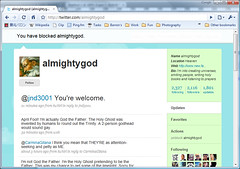![]() Image via CrunchBase
Image via CrunchBase
I'll pass on talking about other organizations that use Twitter like Islamic Relief (a non-profit organization) or Islamic Crunch (focusing on activities of all sorts in the Muslim community) or Talk Islam (blogging all things Islam) -- religious organizations of all sorts are finding Twitter provides a low-cost way to raise awareness and communicate updates.
Instead, I've started following a few church leaders on my own Twitter account and notice a few, distinct uses of the service.
(Caveat: Not all leaders do this ALL the time, but I'll suggest what I see as an informal pattern.)
1. Purposeful - Some leaders consistently stay "on message" through Twitter.
 Image by Josh Russell via Flickr
Image by Josh Russell via Flickr
Leonard Sweet
Erwin McManus
Here's what I mean - some leaders remain vision-focused leaders through Twitter, keeping their followers encouraged, uplifted, and focused on the values and purposes of their life. This includes leaders who post aphorisms, proverbs, quotes, and key phrases with every tweet. Look at Len Sweet's quotes and expansion of Biblical key words. See Erwin McManus's references to being "wide awake."
2. Provocative - Leaders put out questions and "what if" statements to provoke responses.
Naeem Fazal
Alex McManus
There are other leaders who want to initiate dialogue and get reactions. Using a spare 14o characters, they attempt to provoke thinking and prompt follow-up posts from other people. Naeem Fazal tweets, "Question: Do you have an irrational confidence in the faithfullness of God?" and "Is failure resolved by success or by faithfulness ?" and "Was there a time that you trusted God more than you do now ... What happened?" Alex McManus tweets, "Does talent emerge due to external factors (Gladwell, Outliers), proper practice (Coyle, Talent Code), or nature (Gallup, Strengthsfinder)?" and "What would happen if we planted gardens and designed natural sanctuaries instead of planting and building churches?"
3. Promotional - Leaders use Twitter to keep people up to date with their books, speaking engagements, blog posts, and other resources and events surrounding their ministry.
 Image by barron via Flickr
Image by barron via Flickr
Eric Bryant
Ed Stetzer
Church leaders using Twitter are often busy people who travel, speak, write, and consult to groups nearly every day. Their life is a near-constant whirl of activity, and they use Twitter to let people (both friends and "fans") know what's new with them. Eric Bryant links his blog posts to his Twitter account and regularly gives away free copies of his book. And Ed Stetzer continually developes new material which he often makes available on the internet.
4. Personal - Still other leaders talk mostly about their leisure and family activities.
Alan Hirsch
Sam Radford
Church leaders can be very open about the movies they watch, the restaurants they try, and the various happenings with their spouse and children. Reading their posts, you get a feel for the rhythm of their lives away from "the office." Alan Hirsch and Sam Radford are two who keep us informed of their sleep habits, places they visit, conversations with friends, and any "plans-of-the-moment."
5. Mixed-Use
 Image via Wikipedia
Image via Wikipedia
Jay Bakker
Dan Kimball
While some leaders have one primary "Twitter Profile," most have mixed uses. Through a series of tweets, they broadcast vision, provoke thoughts, indicate their speaking and writing activities, and talk about their day-to-day lives -- all in a single day! Jay Bakker and Dan Kimball are faithful in providing their Twitter followers a steady stream of thoughts and activities.
These are the 5 uses of Twitter I see among church leaders today.
Any others I've missed?



1 comment:
Others that are worth following are Mark Driscoll ( @pastormark ) and Russel Moore ( @drmoore ).
Post a Comment